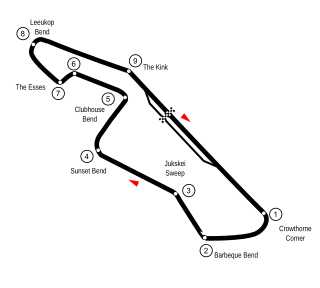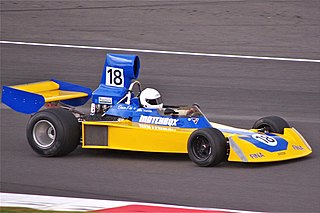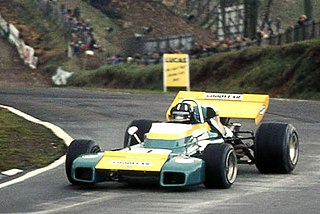 Fittipaldi FD04, 1976 | |||||||||
| Category | Formula One | ||||||||
|---|---|---|---|---|---|---|---|---|---|
| Constructor | Fittipaldi | ||||||||
| Designer(s) | Richard Divila | ||||||||
| Successor | Fittipaldi F5 | ||||||||
| Technical specifications [1] [2] [3] [4] | |||||||||
| Chassis | Aluminium alloy monocoque | ||||||||
| Axle track | Front: 1,500 mm (59 in) Rear: 1,560 mm (61 in) (FD04) Front: 1,500 mm (59 in) Rear: 1,550 mm (61 in) (FD03) | ||||||||
| Wheelbase | 2,341 mm (92.2 in) | ||||||||
| Engine | Ford Cosworth DFV 2,993 cc (182.6 cu in) V8 naturally aspirated, mid-mounted | ||||||||
| Transmission | Hewland FG/FGA 400 6-speed manual | ||||||||
| Weight | 602 kg (1,327 lb) (FD03) 640 kg (1,410 lb) (FD04) | ||||||||
| Tyres | Goodyear | ||||||||
| Competition history | |||||||||
| Notable entrants | Copersucar-Fittipaldi | ||||||||
| Notable drivers | |||||||||
| Debut | 1975 Argentine Grand Prix | ||||||||
| |||||||||
| Constructors' Championships | 0 | ||||||||
| Drivers' Championships | 0 | ||||||||
| n.b. Unless otherwise stated, all data refer to Formula One World Championship Grands Prix only. | |||||||||
The Fittipaldi FD was a series of Formula One chassis designed by Richard Divila and used by Fittipaldi Automotive in the 1975, 1976 and 1977 seasons. The initial chassis was designated Fittipaldi FD01 and there were three minor developments designated, Fittipaldi FD02, Fittipaldi FD03 and Fittipaldi FD04 respectively. FD series cars competed in 37 races making 43 individual entries in total. The chassis achieved a best finish of fourth place at both the 1977 Argentine and Brazilian Grands Prix driven on each occasion by former World Champion and joint team-owner Emerson Fittipaldi. It scored a total of 11 World Championship points.
Formula One is the highest class of single-seater auto racing sanctioned by the Fédération Internationale de l'Automobile (FIA) and owned by the Formula One Group. The FIA Formula One World Championship has been one of the premier forms of racing around the world since its inaugural season in 1950. The word "formula" in the name refers to the set of rules to which all participants' cars must conform. A Formula One season consists of a series of races, known as Grands Prix, which take place worldwide on purpose-built circuits and on public roads.

Ricardo Divila, also known as Richard Divila is a Brazilian motorsports designer. He has worked in Formula One, Formula Two, Formula Three, Formula 3000 and sports car racing.
Fittipaldi Automotive, sometimes called Copersucar after its first major sponsor, was the only Formula One motor racing team and constructor ever to be based in Brazil. It was formed during 1974 by racing driver Wilson Fittipaldi and his younger brother, double world champion Emerson, with money from the Brazilian sugar and alcohol cooperative Copersucar. The team raced under a Brazilian licence. In 1976, Emerson surprised the motor racing world by leaving the title-winning McLaren team to drive for the unsuccessful family outfit. Future world champion Keke Rosberg took his first podium finish in Formula One with the team.





























